Rio Tinto Bundle
How Does Rio Tinto Dominate the Global Mining Market?
Founded in 1873, Rio Tinto has evolved from a copper mining operation to a global powerhouse, but how does this mining giant actually sell its vast array of essential materials? From iron ore to lithium, the company's Rio Tinto SWOT Analysis reveals a strategic approach to sales and marketing that's crucial for its continued success. Discover the secrets behind Rio Tinto's impressive financial performance and its ability to navigate a complex and competitive global market.
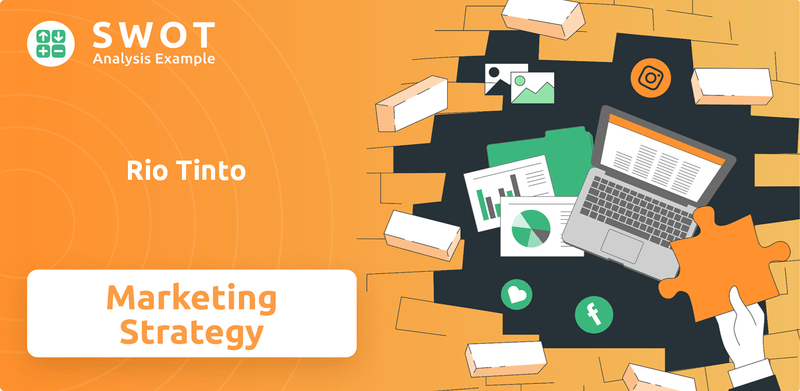
This article unveils the intricacies of Rio Tinto's sales and marketing strategy, offering a deep dive into its primary sales channels, and integrated business model. We'll explore how Rio Tinto, a leading Rio Tinto mining company, leverages digital marketing, sustainability marketing, and tailored customer solutions to drive sales and maintain its competitive edge. Understand the challenges and opportunities within Rio Tinto's sales and marketing team as they shape the future of the mining industry, including their future marketing plans.
How Does Rio Tinto Reach Its Customers?
The sales channels of the company, a leading global mining group, primarily operate on a business-to-business (B2B) model. This approach involves direct distribution of its diverse mineral resources, including iron ore, aluminum, copper, and diamonds, to industrial customers worldwide. The company's sales strategy is deeply integrated into its extensive supply chain, which encompasses exploration, mining, refining, and final delivery.
A cornerstone of the company's sales strategy is the establishment of long-term supply contracts with major industrial buyers. These contracts provide a stable revenue stream and help mitigate the inherent volatility of commodity markets. In 2024, the company served approximately 1,730 customers across various industries and countries, highlighting its broad market reach.
The company's global distribution network leverages maritime shipping routes, connecting to over 40 international ports, and direct rail transportation networks in Australia and Canada. This integrated approach allows the company to maintain control over product quality, reliability, and supply chain efficiency. The company also engages in spot market sales to balance its revenue streams.
The company relies heavily on direct sales teams and key account management to cultivate and maintain personalized relationships with its industrial clients. This approach is crucial for understanding customer needs and providing tailored solutions. The company's sales and marketing team focuses on building strong, long-term partnerships.
The company's global distribution network is a critical component of its sales strategy. It utilizes maritime shipping routes, connecting to over 40 international ports, and direct rail transportation networks in Australia and Canada. This integrated approach ensures efficient and reliable delivery of products to customers worldwide.
In addition to long-term contracts, the company engages in spot market sales to diversify its revenue streams and respond to short-term market fluctuations. This flexibility allows the company to optimize sales performance and adapt to changing market conditions. This strategy helps in managing price volatility.
The company is increasingly focused on sustainability and traceability in its products. The expansion of the START™ sustainability label to cover copper cathodes, metal powders, and salt provides customers with ESG metrics related to sourcing and production. This focus aligns with growing customer demand for sustainable products.
The company is strategically expanding its portfolio, particularly in materials essential for the energy transition. The acquisition of Arcadium Lithium is a key move to bolster production capacity and accelerate its entry into the battery metals market. This diversification is part of a broader strategy to capitalize on growing demand for materials like lithium.
- The company's sales strategy is heavily reliant on long-term contracts.
- Direct sales teams and key account management are crucial for customer relationships.
- The company is increasing its focus on sustainability and traceability.
- Strategic diversification includes expansion into the lithium sector.
Rio Tinto SWOT Analysis
- Complete SWOT Breakdown
- Fully Customizable
- Editable in Excel & Word
- Professional Formatting
- Investor-Ready Format
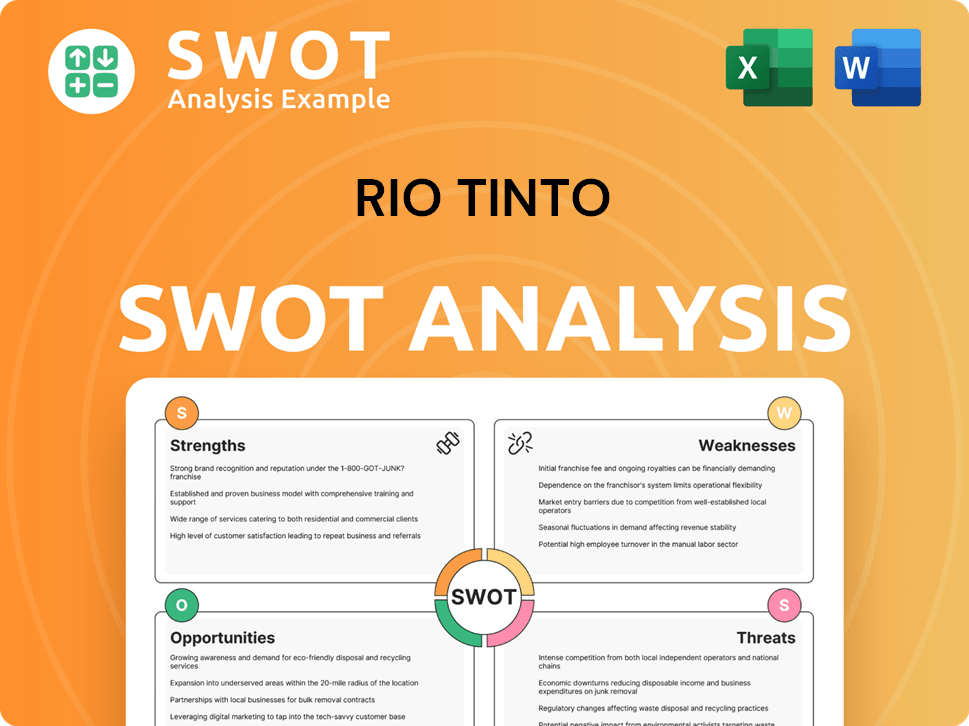
What Marketing Tactics Does Rio Tinto Use?
The Growth Strategy of Rio Tinto incorporates a multifaceted approach to sales and marketing, primarily focused on B2B engagement. This strategy aims to build brand awareness, generate leads, and drive sales within the global mining and metals industry. Rio Tinto's marketing efforts emphasize reliability, quality, technological innovation, and a strong commitment to sustainability, crucial for their industrial customer base.
In 2024, Rio Tinto's marketing strategy prioritized digital initiatives and global branding. The company leverages digital platforms, including social media and its website, to communicate its purpose, strategy, and sustainability efforts. This approach is designed to reach a wide audience and reinforce its commitment to environmental responsibility and community engagement.
Traditional marketing methods, such as industry events and reports, complement digital efforts. Rio Tinto also focuses on customer segmentation and relationship management to tailor its marketing campaigns and ensure customer satisfaction. This integrated approach helps meet diverse customer needs and supports their decarbonization goals.
Rio Tinto has focused on increasing engagement on social media, reporting a 20% increase in engagement in the last quarter of 2024. This digital outreach promotes corporate branding centered on sustainability and community involvement. Digital tactics are a significant part of their marketing strategy.
The company leverages its website to communicate its purpose, strategy, and sustainability efforts. This includes its goal to reduce operational emissions by 50% by 2030 and achieve net zero by 2050. The website serves as a central hub for information and engagement.
Rio Tinto's partnerships with technology providers like Palantir Technologies for its Artificial Intelligence Platform (AIP) and Foundry demonstrate its commitment to data-driven decision-making. These partnerships optimize operations and enhance supply chain processes. This is a key element of their business strategy.
Traditional marketing approaches include participation in industry events and conferences. Publishing sustainability and compliance reports to engage stakeholders is also part of the strategy. These efforts help maintain relationships within the industry.
Rio Tinto's approach to customer segmentation is crucial, utilizing geographic, demographic, psychographic, and behavioral factors to gain insights. This helps craft personalized marketing campaigns. Understanding the customer base is essential.
The company emphasizes customer relationship management (CRM) through personalized service and key account management. This ensures tailored solutions and technical support. CRM is a core component of their sales strategy.
Rio Tinto's marketing tactics are designed to build brand awareness and drive sales. These tactics are tailored to the B2B market and emphasize sustainability and technological innovation. The focus is on long-term customer relationships.
- Digital Engagement: Increased social media engagement and website communication.
- Sustainability Reporting: Publishing reports to demonstrate environmental commitment.
- Technology Partnerships: Collaborating with tech providers for data-driven decisions.
- Industry Events: Participating in conferences and events to engage stakeholders.
- Customer Segmentation: Utilizing various factors to understand customer needs.
- CRM: Providing personalized service and key account management.
Rio Tinto PESTLE Analysis
- Covers All 6 PESTLE Categories
- No Research Needed – Save Hours of Work
- Built by Experts, Trusted by Consultants
- Instant Download, Ready to Use
- 100% Editable, Fully Customizable
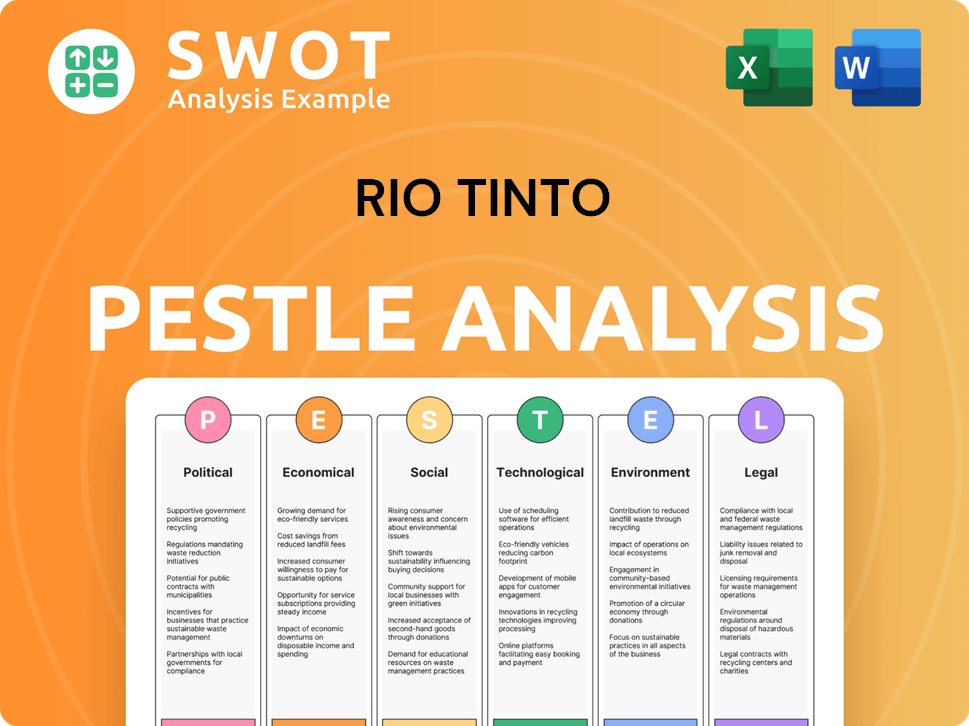
How Is Rio Tinto Positioned in the Market?
Rio Tinto positions its brand as a leading global mining group, emphasizing its role in providing essential materials for human progress. The core message is centered around 'Finding better ways™ to provide the materials the world needs.' This focus supports its brand identity, which is marked by ethical business practices, environmental stewardship, and community development. This approach is crucial for its Rio Tinto sales strategy and overall Rio Tinto business strategy.
The company differentiates itself through a diverse portfolio of high-quality minerals and metals, including iron ore, aluminum, copper, and diamonds, as well as its strategic shift towards materials critical for the energy transition, such as lithium. This diversification supports its Rio Tinto marketing strategy by allowing it to cater to a broad range of industrial customers and investors. Furthermore, the company's commitment to sustainability and innovation is a key element of its brand positioning.
Rio Tinto's brand consistency is maintained across various touchpoints, from its official website and annual reports to its engagement with suppliers and local communities. The company actively integrates market insights and investor feedback into its operational frameworks. Transparency, such as publishing a Taxes Paid report since 2010, builds trust and credibility. For a deeper understanding of how it competes, consider exploring the Competitors Landscape of Rio Tinto.
Rio Tinto's key message revolves around 'Finding better ways™ to provide the materials the world needs,' emphasizing its commitment to innovation and sustainability.
The primary target audience includes industrial customers and investors, with a focus on providing reliable supply chains and advanced technological solutions.
Rio Tinto differentiates itself through its diversified portfolio of high-quality minerals and metals, including iron ore, aluminum, copper, and diamonds, and its strategic pivot towards materials critical for the energy transition like lithium.
The company highlights its efforts in decarbonization, with a goal to reduce Scope 1 and 2 emissions by 50% by 2030, and its use of hydroelectricity in aluminum production, resulting in significantly lower carbon emissions compared to the industry average.
Rio Tinto Business Model Canvas
- Complete 9-Block Business Model Canvas
- Effortlessly Communicate Your Business Strategy
- Investor-Ready BMC Format
- 100% Editable and Customizable
- Clear and Structured Layout
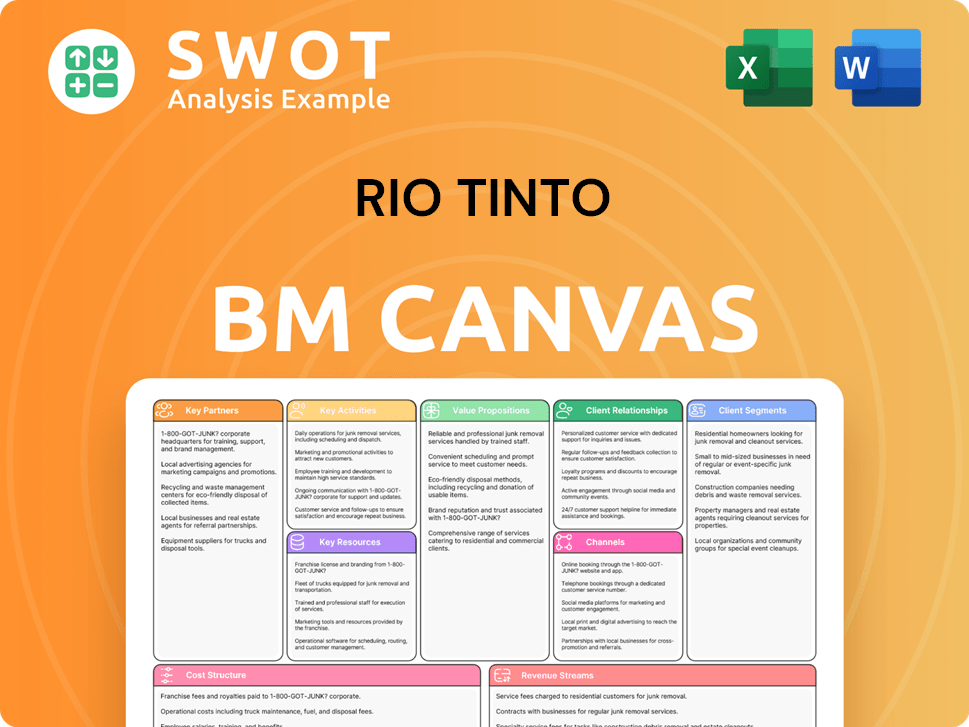
What Are Rio Tinto’s Most Notable Campaigns?
In the realm of a Brief History of Rio Tinto, the company's approach to sales and marketing is multifaceted, adapting to its B2B operational environment. The core of its strategy revolves around the overarching theme of 'Finding better ways™,' emphasizing innovation, sustainability, and responsible resource provision. This approach is consistently integrated into its communications and initiatives, reflecting a long-term commitment to these values.
While direct sales lifts from branding campaigns are not always immediately apparent, Rio Tinto focuses on building a positive brand perception and attracting future talent. The company's strategic moves are communicated through investor seminars and financial reports, aiming to boost investor confidence and market share. This dual approach of brand building and strategic communication is central to the company's sales and marketing efforts.
Rio Tinto's marketing and sales strategies are also heavily influenced by market analysis and the competitive landscape. The company's focus on key minerals such as lithium and copper highlights its proactive approach to meeting increasing global demand. These strategic decisions are essential in shaping its future marketing plans and sales performance.
This podcast aims to broaden Rio Tinto's reach beyond its traditional business audience. It seeks to repair reputational damage by highlighting the essential nature of the materials it provides. The podcast features engaging conversations with diverse guests, tapping into educational entertainment to win hearts and minds.
Rio Tinto is aggressively expanding into lithium production and copper growth for the energy transition. The US$6.7 billion acquisition of Arcadium Lithium, announced in 2025, demonstrates this commitment. This strategic pivot is heavily marketed to investors and industry stakeholders through financial reporting and strategic announcements.
Investor seminars and financial reports are crucial for communicating the company's diversified growth plans. These communications highlight the company's ability to meet the increasing global demand for critical minerals. The focus is on transparency and building investor confidence.
Rio Tinto integrates sustainability into its marketing efforts, showcasing responsible resource provision. This includes highlighting the company's commitment to environmental stewardship and community engagement. Sustainability is a core element of its brand positioning.
The primary objective is to meet the increasing global demand for critical minerals, driven by electric vehicle adoption and industrial decarbonization. The company aims to boost investor confidence and market share in these growing sectors.
The target audience includes investors, industry stakeholders, and the broader public. The podcast series targets a wider audience to improve brand perception. Investor relations focus on financial analysts and institutional investors.
Challenges include navigating environmental concerns and maintaining a positive brand image. The company's future marketing plans address these challenges by emphasizing sustainability and responsible practices. The brand positioning is critical.
Digital marketing strategy includes investor relations, financial reporting, and the podcast series. The company uses various digital platforms to communicate its growth plans and sustainability initiatives. The focus is on transparency.
Rio Tinto projects a 4% volume growth for 2025, underpinned by strategic investments in lithium and copper. Sales performance is closely tied to the company's ability to meet the increasing global demand for these critical minerals.
Customer relationship management focuses on building strong relationships with investors and industry stakeholders. This includes regular communication through financial reports and strategic announcements. The goal is to build trust.
Rio Tinto Porter's Five Forces Analysis
- Covers All 5 Competitive Forces in Detail
- Structured for Consultants, Students, and Founders
- 100% Editable in Microsoft Word & Excel
- Instant Digital Download – Use Immediately
- Compatible with Mac & PC – Fully Unlocked
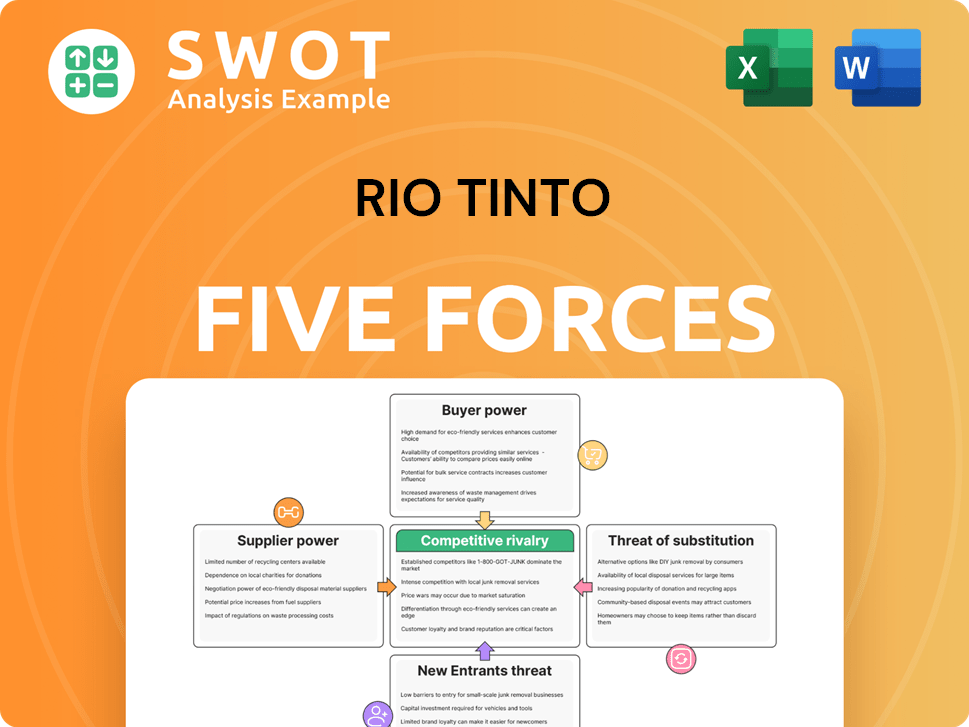
Related Blogs
- What are Mission Vision & Core Values of Rio Tinto Company?
- What is Competitive Landscape of Rio Tinto Company?
- What is Growth Strategy and Future Prospects of Rio Tinto Company?
- How Does Rio Tinto Company Work?
- What is Brief History of Rio Tinto Company?
- Who Owns Rio Tinto Company?
- What is Customer Demographics and Target Market of Rio Tinto Company?
Disclaimer
All information, articles, and product details provided on this website are for general informational and educational purposes only. We do not claim any ownership over, nor do we intend to infringe upon, any trademarks, copyrights, logos, brand names, or other intellectual property mentioned or depicted on this site. Such intellectual property remains the property of its respective owners, and any references here are made solely for identification or informational purposes, without implying any affiliation, endorsement, or partnership.
We make no representations or warranties, express or implied, regarding the accuracy, completeness, or suitability of any content or products presented. Nothing on this website should be construed as legal, tax, investment, financial, medical, or other professional advice. In addition, no part of this site—including articles or product references—constitutes a solicitation, recommendation, endorsement, advertisement, or offer to buy or sell any securities, franchises, or other financial instruments, particularly in jurisdictions where such activity would be unlawful.
All content is of a general nature and may not address the specific circumstances of any individual or entity. It is not a substitute for professional advice or services. Any actions you take based on the information provided here are strictly at your own risk. You accept full responsibility for any decisions or outcomes arising from your use of this website and agree to release us from any liability in connection with your use of, or reliance upon, the content or products found herein.